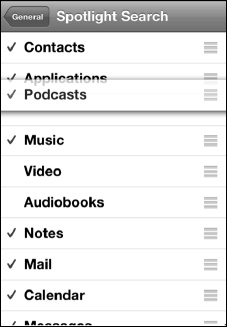Chapter 2
Typing, Copy, and Search
In this chapter, we will show you some good ways to type on your iPhone and save valuable time when doing so. Along the way, we’ll show you how to use the Portrait (vertical/smaller) and Landscape (horizontal/larger) keyboards. We will also teach you how to select different language keyboards, how to type symbols, and other tips.
Later in this chapter, we will tell you about the Spotlight search and the Copy and Paste function. The Copy and Paste function will save you lots of time, as well as increase your accuracy when working with your iPhone.
Typing on Your iPhone
You will quickly find two on-screen keyboards on your iPhone: the smaller Portrait keyboard that’s visible when you hold your iPhone in a vertical orientation and the larger Landscape keyboard that’s visible when you hold the iPhone in a horizontal orientation. The nice thing is that you can choose whichever keyboard works best for you.
Typing on the Screen with Two Thumbs
You will find when you first start out with your iPhone that you can most easily type with one finger—usually your index finger—while holding the iPhone with the other hand.
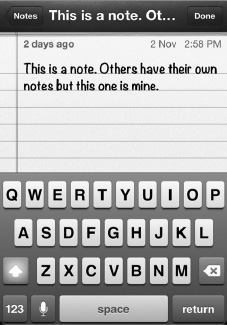
After a little while, you should be able to experiment with thumb typing (as you see so many people doing with other phones, such as the BlackBerry smartphones). Once you practice a little, typing with two thumbs instead of a single finger will really boost your speed. Just be patient: it does take practice to become proficient typing quickly with your two thumbs.
You will actually notice after a while that the keyboard touch sensitivity assumes you are typing with two thumbs. What this means is that the letters on the left side of your keyboard are meant to be pressed on their left side, and the keys on the right are meant to be pressed on their right side.
Simply turning the iPhone sideways in many apps will cause the keyboard to change to the larger Landscape keyboard, which makes it easier to type.
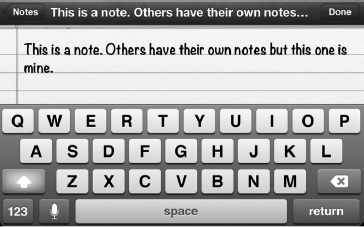
TIP: If you have larger hands and find typing on the smaller, vertical keyboard challenging, then flip your iPhone on its side to get the larger, Landscape keyboard.
Type Quick Phrases with Shortcuts
One nice feature on your iPhone is the ability to set up shortcuts for typing common phrases or even a few sentences like directions to your home or office.
TIP: Use Shortcuts to save time when typing common phrases on your iPhone. You can even use Shortcuts to type a few sentences like steps to get to your home or something you type frequently.
Access shortcuts in the Settings app. Tap the Settings icon, then General, then Keyboard and swipe to the bottom of the screen to see available Shortcuts.
Apple has supplied you with an example shortcut for “omw.” When you type omw on your iPhone, you will see that the pop-up shows the phrase “On my way!”

Tap Add New Shortcut to create a new one.

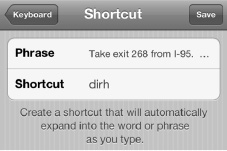
Type the Phrase which will replace the shortcut, then type the Shortcut itself. In this example, we want a shortcut to type directions to our home. So our Shortcut is “dirh” and the Phrase is step by step directions to get to our house. Save your new shortcut and give it a try.
Saving Time with Auto-Correction
After you have been typing for a while, you will begin to notice a little pop-up window directly below some of the words you are typing—this feature is called Auto-Correction. Any Shortcuts that you have defined will also appear as the pop-up suggestion.
NOTE: If you never see the Auto-Correction pop-up window, then you will have to enable the Auto-Correction feature by going into your Settings app ![]() General
General ![]() Keyboard, and then setting Auto-Correction to ON.
Keyboard, and then setting Auto-Correction to ON.

You can save yourself time when you see the correct word guessed by just pressing the Space key at the bottom of the keyboard; doing so will select that word.
In the next example, we start typing the word “especially”; and when we get to the “c” in the word, the correct word appears below in a pop-up window. To select it, we simply press the Space key at the bottom (see Figure 2–1).
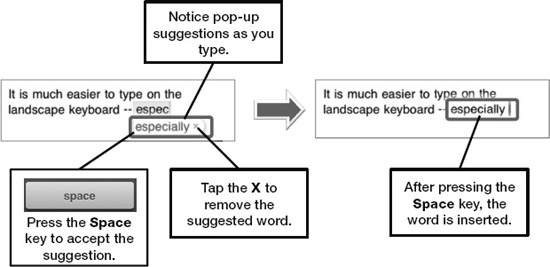
Figure 2–1. Using Auto-Correction and suggested words
Your first inclination might be to tap the pop-up word, but that simply erases the suggested word from the screen. It is ultimately faster to keep typing or press the Space key when you see the correct word pop up. In most situations, the word will either be correct or will become correct as you keep typing—and this means less finger travel in the long run.
TIP: The Auto-Correction feature also looks through your Contacts list to make suggestions. For example, if Martin Trautschold were in your Contacts list, you would see “Trautschold” come up as an Auto-Correction suggestion after typing “Trauts.”
After you learn to use the Space key, you will see that this pop-up guessing can be quite a time saver. After all, you were going to have to type a space at the end of the word, anyway.
Sometimes you accidentally accept an incorrect Auto-Correction word; in this case, you simply need to press the Backspace key. ![]() Doing so will make a pop-up window appear that contains the original word before the Auto-Correction feature changed it. You will also see other suggested replacements (see Figure 2–2).
Doing so will make a pop-up window appear that contains the original word before the Auto-Correction feature changed it. You will also see other suggested replacements (see Figure 2–2).
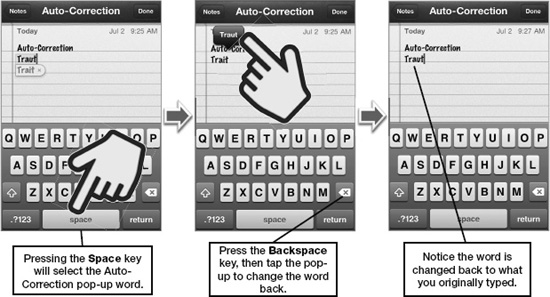
Figure 2–2. Dealing with Auto-Correction words that are not correct
TIP: With Auto-Correction, you can save time by avoiding typing the apostrophe in many common contractions, such as “wont” and “cant.” Auto-Correction will show you a little pop-up window with the contraction spelled correctly; all you need to do to select the highlighted correction is press the Space key.

With some words, you have to add an extra character for the Auto-Correction feature to figure out what you mean:
- Type “Weree” to get “We’re.”
- Type “Welll” to get “We’ll.”
Hearing Auto-Correction Words Out Loud
You can set your iPhone to speak the Auto-text and Auto-Correction words as they appear. This might help you to select the correct word. Follow these steps to enable this type of speaking:
- Tap the Settings icon.
- Tap General.
- Tap Accessibility near the bottom of the page (you need to swipe down).
- Set the switch next to Speak Auto-text to ON.
After you enable this feature, you will hear the Auto-Correction word that pops up spoken aloud as you are typing. If you agree with the word you hear, press the Space key to accept it; otherwise, keep typing. This can save you some time from looking up from the keyboard.
Spell Checker
Working together with the Auto-Correction feature is your built-in iPhone Spell Checker. Most of the time, your misspelled words will be caught and corrected automatically by Auto-Correction. Other times, a word will not be corrected, but it is still misspelled. You will see any words that the iPhone thinks are misspelled underlined with a red dotted line, as shown in Figure 2–3.
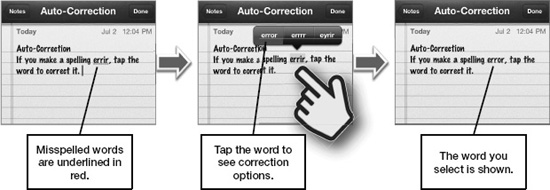
Figure 2–3. Using the built-in Spell Checker feature
TIP: If your Spell Checker has too many incorrect words, then you can give it a fresh start by clearing out all the custom words. Follow these steps to do so:
1. Tap your Settings icon.
2. Tap General.
3. Tap Reset near the bottom.
4. Tap Reset Keyboard Dictionary.
5. Tap Reset Dictionary to confirm.
Following the preceding steps will clear out all custom words that have been added to your iPhone’s dictionary.
Accessibility Options
There are a number of useful features on the iPhone to help with accessibility. For example, the VoiceOver option will read various things displayed on the screen to you. It will tell you what elements you tap, what buttons are selected, and all the options available. It will read entire screens of text, as well. If you like to see things larger, you can also turn on the Zoom option, as described in the “Using Zoom to Magnify the Entire Screen” section later in this chapter.
Getting Your iPhone to Speak To You (VoiceOver)
One cool iPhone feature is the VoiceOver option. Turning this on will make your phone speak anything displayed on the screen. You can even get it to read to you from any e-mail, text document, or even an iBook page.
TIP: Use your headphones when the VoiceOver option is set to ON and you are in a public place; this will help you hear what is said more easily, but avoid bothering others.
Follow these steps to enable the VoiceOver feature:
- Tap the Settings icon.
- Tap General.
- Tap Accessibility near the bottom of the page.
- Tap VoiceOver.
- Set the VoiceOver switch to ON.
CAUTION: As shown on the screen to the right, the VoiceOver gestures are different from the normal gestures. Tap the Practice VoiceOver Gestures button to get used to them.

Here are some additional tips for using the VoiceOver feature:
- Scroll down the VoiceOver screen to see more settings.
- Adjust whether or not hints are spoken by changing the setting for the Speak Hints option.
- When you type with VoiceOver, by default every character you type will be spoken. You can change this by tapping Typing Feedback. On the next screen, you can set this option to Characters, Words, Characters and Words, or Nothing.
- Adjust the Speaking Rate by sliding the bar beneath this option.
- Adjust whether Phonetics and Pitch Change are used by setting the switches.
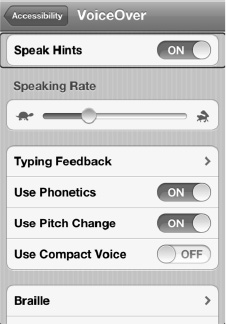
To have an entire page read to you in the Notes or iBooks app, you need to simultaneously tap the bottom and top of the block of text on the screen. If you tap in the text with one finger, only a single line is read to you.
Speak Selection and Speak Auto-text
The Speak Selection feature is similar to VoiceOver, but it ties into the Copy and Paste feature, adding a Speak option to the selected text pop-up menu. The Speak Auto-text feature will say out loud any text that is automatically capitalized or corrected by the spelling dictionary.
With the Speak Selection feature, you can adjust the Speaking Rate using the same type of slider that the VoiceOver feature uses. The Speak Auto-text option can only be toggled ON or OFF.
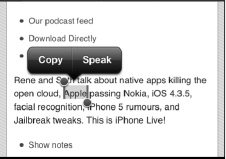
Using AssistiveTouch
If you have difficulty touching the screen or have a special accessory that helps you with the touch screen, you will want to turn on AssistiveTouch. You do this in the same Accessibility section of Settings.
Once you turn it on, you will see a small white circle in the lower right corner of your screen. Tap the small circle to bring up the AssistiveTouch menu.

Assistive touch will allow you to do the following:
- Tap Gestures, to simulate, 2, 3, 4 or 5 finger gestures.
- Tap Favorites to access your custom gestures.
- Tap Device to access common device commands such as screen rotation, mute, volume, shake and lock screen.
- Tap the Home icon to simulate actually clicking the Home button.
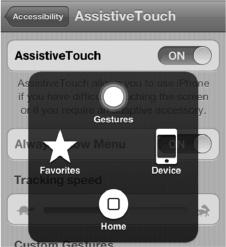
You can even set up custom gestures to access from the Favorites menu.
Tap Create New Gesture, then use your fingers to make an on-screen gesture by moving your fingers on the screen. You will see white lines follow the location of your finger tips.
Then, tap the Stop button.
Press Play to see if your gesture is correct and finally, tap Save at the top and give your new gesture a name.
You will then see your new gesture appear in the Favorites menu in Assistive Touch.
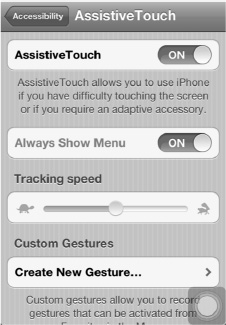
Using Zoom to Magnify the Entire Screen
You may want to turn on the Zoom feature if you find the text, icons, buttons, or anything else on the screen a little too hard to see. With the Zoom feature turned on, you can zoom the entire screen to almost twice its normal size—everything is much easier to read.
NOTE: You cannot use VoiceOver and Zoom at the same time; you need to choose one or the other. Instead of magnifying the entire screen, you can also increase just the font sizes for your major apps using the Large Text feature. We will show you how in the “Use Larger Text Size for Easier Reading” section.
Follow these steps to enable the Zoom feature:
- Tap the Settings icon.
- Tap General.
- Tap Accessibility near the bottom of the page.
- Tap Zoom.
- Set the switch next to Zoom to ON.
Similar to VoiceOver, Zoom uses three-fingered gestures. Make sure to study these before you leave this screen.
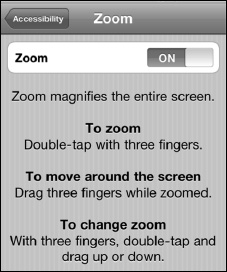
White on Black
If the contrast and colors on your screen are difficult to see, then you might want to set the White on Black setting to ON. Follow these steps to do so:
- Go to the Accessibility screen in the Settings app, as shown previously.
- Set the White on Black switch to ON. With this option set to ON, everything that was light on the screen becomes black, and everything that was dark or black becomes white.
Use Larger Text Size for Easier Reading
You can really expand the size of your fonts in the Contacts, Mail, Messages, and Notes apps by using the Large Text feature. Follow these steps to do so:
- Tap the Settings icon.
- Tap General.
- Tap Accessibility near the bottom of the page (you need to swipe down).
- Tap Large Text. You will then see a screen of font size options: Off, 20pt text, 24pt text, 32pt text, 40pt text, 48pt text, and 56pt text. Tap the size you want to use. The image shown to the right uses the 48pt font.
- Tap the Accessibility button in the upper-left corner to return to the previous screen, then tap the Home button to exit Settings.

Triple-Click Home Button Options
You can set a triple-click of the Home button to do various things related to accessibility. Follow these steps to adjust these options:
- Go to the Accessibility screen in the Settings app, as shown previously.
- Tap Triple-click the Home Button near the bottom of the page.
- Choose from Off, Toggle VoiceOver, Toggle White on Black, or Ask.
Using the Magnifying Glass for Editing Text or Placing the Cursor
How many times have you been typing something and wanted to move the cursor precisely between two words or letters?
This can be hard to do until you figure out the Magnifying Glass trick. What you do is this: Touch and hold your finger on the place where you want the cursor (see Figure 2–4). After a second or two, you will see the Magnifying Glass icon appear. Then, as you hold your finger on the screen, slide it around to position the cursor. When you let go, you will see the Copy and Paste pop-up menu, but you can ignore it.
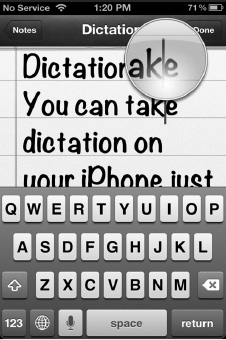
Figure 2–4. Touch and hold the screen to see the Magnifying Glass icon and place the cursor.
Typing Numbers and Symbols
How do you type a number or a symbol using the iPhone’s on-screen keyboard? When you are typing, tap the 123 key in the lower-left corner to see numbers and common symbols such as $ ! ~ & = # . _ - +. If you need more symbols, from the Numbers keyboard tap the #+= key just above the ABC key in the lower-left corner (see Figure 2–5).
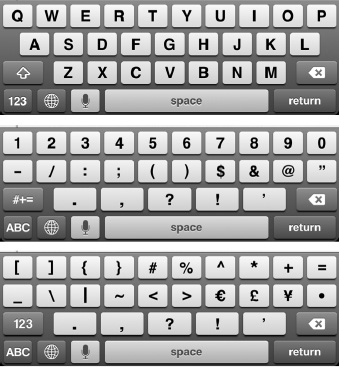
Figure 2–5. Switching between the Letters, Numbers, and Symbols keyboards
TIP: After you type a number or symbol, notice that the Numbers keyboard will stay active until you either hit the Space key or press the key for another keyboard, such as the ABC key for the Letters keyboard.
Touch and Slide Trick
One cool technique that you can apply in various areas is the touch-and-slide trick. We’ll cover what this is and how you can take advantage of it in the next couple of sections.
Typing Uppercase Letters
To type uppercase letters, you would normally press the Shift key, and then press the desired letter.
The faster way to type single uppercase letters and symbols that require the Shift key is to press the Shift key, keep your finger on the keyboard, slide over to the key you want, and then release.
For example, to type an uppercase “D,” press the right Shift key, then slide over to the D key and release.

Rapidly Typing a Single Number
If you have to type just a single number, then press the 123 key and slide your finger up to the number. However, to type several numbers in a row, it’s best to press the 123 key, let go, and then press each number.
Press and Hold Keyboard Shortcut for Typing Symbols and More
You might wonder how you can type symbols not shown on the keyboard.
TIP: You can type more symbols than are shown on the screen.
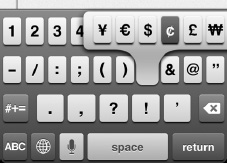
All you do is press and hold a letter, number, or symbol that is related to the symbol you want.
For example, if you want to type the YEN symbol (¥), you press and hold the $ key until you see the other options. Next, slide up your finger to highlight the YEN symbol, and then let go.
This tip also works with the .com key in the Safari web browser and when typing e-mail addresses by pressing and holding the Period (.) key. You can get additional web site suffixes by pressing and holding the .com or Period keys.
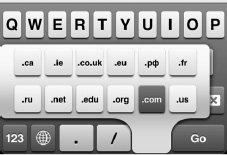
The preceding figure shows the .co, uk, .ie, .de, .ca, and .eu keys. These keys are not displayed on the standard US keyboard, but they are present in this case because we have installed additional international keyboards. You will learn how to enable international keyboards in the “Typing in Other Languages—International Keyboards” section later in this chapter.
TIP: A Few More Useful but Hidden Symbols
There is a good bullet point character on the Symbols keyboard just above the Backspace key. You can also get a degree symbol if you press and hold the Zero key (0). Also, you can press and hold the ? and ! keys to get their inverted Spanish cousins.
Caps Lock
You double-press the Shift key to turn on the Caps Lock feature. You know it’s turned on when the Shift key turns blue. ![]()
To turn off Caps Lock, simply press the Shift key ![]() again.
again.
Quickly Selecting and Deleting or Changing Text
You may need to quickly change or delete some text you are typing. Follow these steps to do so:
- Select a part of the text you want to change or delete by double-tapping it.

- Adjust the selection by dragging the blue handles.

- To erase the selected text, press the Backspace key.


- To replace the text, simply start typing. The text will be instantly replaced by the letters you type.
Keyboard Options and Settings
There are a few keyboard options to make typing on your iPhone easier. These keyboard options are located in the General tab of your Settings app. Follow these steps to access them:
- Tap the Settings icon.
- Tap General.
- Swipe up, then tap Keyboard near the bottom of the page.
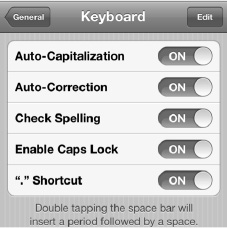
Setting Auto-Correction to ON or OFF
As noted earlier in this chapter, the Auto-Correction feature will use the iPhone’s built-in dictionary to automatically make changes to commonly misspelled words. You need to make sure it is ON if you want this feature to work. (This is the default setting.)
Auto-Capitalization
When you start a new sentence, words will automatically be capitalized if the Auto-Capitalization option is set to ON.
This feature will also correctly capitalize common proper nouns. For example, if you type “New york,” then you will be prompted to change it to “New York”—again, just pressing the Space key will implement the correction. If you backspace over a capital letter, the iPhone will assume the new letter you type should be capitalized, as well. This feature is also set to ON by default.

Enabling Caps Lock
Sometimes you may want to type only capital letters; to do so, simply double-tap the Caps key.
This feature is set to OFF by default.
The “.” Shortcut
If you double-press the Space key, it will automatically put in a period at the end of a sentence; this feature is set to ON by default.
Typing in Other Languages—International Keyboards
At the time of writing, the iPhone enables you to type in more than a dozen different languages, including everything from Dutch to Spanish. Some of the Asian languages, such as Japanese and Chinese, offer two or three keyboards for different typing methods.
Adding a New International Keyboard
Follow these steps to enable various language keyboards:
- Tap the Settings icon.
- Tap General.
- Tap Keyboard near the bottom of the page.
- Tap International Keyboards.
- Tap Add New Keyboard.
- Tap any keyboard or language listed to add it. You will now see the keyboard appear on the list of available keyboards.
- There is a good bullet point character on the Symbols keyboard just above the Backspace key. You can also get a degree symbol if you press and hold the Zero key (0). Also, you can press and hold the ? and ! keys to get their inverted Spanish cousins.
TIP: iOS 5 includes a built –in Emoji keyboard. Emoji is an extensive collection of Japanese symbols, including various smiley and frowny faces, holiday images, buildings and vehicles, and much more. While their meanings are more specific in Japan, people around the world have begun using them in SMS, Twitter, and other online messaging services.
The Emoji keyboard can be added in Settings just like any other keyboard.

Editing, Re-Ordering, or Deleting Keyboards
You may want to adjust options for a keyboard, re-order how the keyboards appear in a list, or simply remove a keyboard that you no longer use. Follow these steps to do so:
- Follow Steps 1–4 under the “Adding a New International Keyboard” section earlier in this chapter; this will let you view the list of international keyboards.
- To adjust options for a specific keyboard, tap it in the list of keyboards. In our example, we tapped French (Canada).
- Change the Software Keyboard Layout by tapping the choice in that section.
- Adjust the Hardware Keyboard Layout by tapping a choice in that section.
- Tap the Keyboards button in the upper-left corner to save your choices and return to the list of keyboards.

- To re-order or delete a keyboard, tap the Edit button in the upper-right corner.
- To change the order of keyboards, touch and drag the right edge of the keyboard with the three gray bars up or down.
- To delete a keyboard, tap the Red Minus Sign so it swings to the vertical position, then tap Delete.
- To finish editing your keyboards, tap the Done button in the upper-right corner.
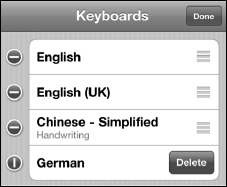
You will notice a little Globe key appears when you install at least one international keyboard. Press the Globe key to cycle between all the languages.
TIP: You can press and hold the Globe key to see a list of available keyboards. This will enable you to quickly select the keyboard you wish to use. If
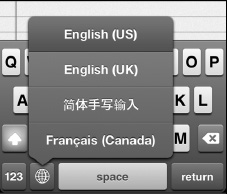
Japanese, Chinese, and some other languages provide several keyboard options to meet your typing preferences.
In some of the languages (such as Japanese), you will see the letters typed change into characters, or you can draw the characters yourself. You may also see a row of other character combinations above the keyboard. When you see the combination you want, tap it.
Copy and Paste
The Copy and Paste feature is very useful for saving time and increasing your typing accuracy. You can use this feature to take text from your e-mail (such as meeting details) and paste it into your calendar. Or you may want to simply copy an e-mail address from one place in a form into another to save yourself the time required to retype it. (We show you this technique in the “Setup Exchange/Google Account” section of Chapter 4: “Other Ways to Sync.”) There are many places to use Copy and Paste; the more comfortable you are with it, the more you will use it. You can even copy text or images from your Safari web browser and paste them into a Notes or Mail message.
Selecting Text by Double-Tapping It
If you are reading or typing text, you can double-tap it to start selecting some text to copy. This works well in the Mail, Messages, and Notes apps.
You will see a box with blue dots (handles) at opposite corners.

Just drag the handles to select the text you wish to highlight and copy.

TIP: If you want to select all the text, tap the cursor or double-tap the screen above or below the text. This will display a pop-up window that shows you Select and Select All options. Tap Select to select a word or tap Select All to highlight all the text.
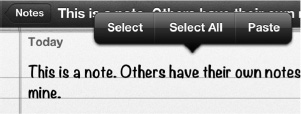
Selecting Text with Two-Finger Touch
The other way to select text requires that you touch the screen simultaneously with two fingers. This seems to work best if you are holding your iPhone with one hand and use your thumb and forefinger from your other hand to touch the screen. You can also set the iPhone down on the table and touch the screen with a finger from both hands. Follow these steps to use this approach:
- Touch the screen simultaneously at the beginning and end of the text you want to select. Don’t worry if you cannot get the selection exactly on the first touch.
- After the two-finger touch, use the blue handles to drag the beginning and end of the selection to the correct positions.
Selecting a Web Site or Other Non-Editable Text with Touch and Hold
In the Safari web browser and other places where you cannot edit the text, hold your finger on some text and the paragraph will become highlighted with handles at each of the corners.
Next, drag the handles if you want to select even more text.
NOTE: If you drag smaller than a paragraph, the selector will switch to fine-text mode and give you the blue handles on both ends of the selection to pick just the characters or words you want. If you drag your finger beyond a paragraph, you get the gross-text selector, which you can drag up or down to select whole reams of text and graphics.
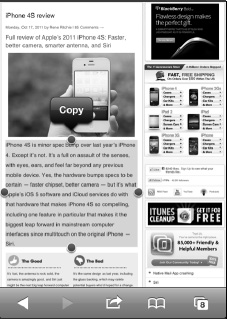
Cut or Copy the Text
Once you have highlighted the text that you wish to copy, just touch the Copy tab at the top of the screen. The tab will turn blue, indicating that the text is on the clipboard.
NOTE: If you have previously cut or copied text, then you will also see the Paste option, as shown to the right.

App Switching and Multitasking
After you copy text, you may want to paste it into another app. For example, you might want to copy some text from Safari and paste it into Notes or a Mail message. The easiest way to jump between apps is to use the App Switcher app. Follow these steps to paste text from one app into another:
- Copy or cut your text.
- Double-tap the Home button to bring up the App Switcher app on the bottom of your screen
- If you just left an app running in the background, you will be able to find it in the App Switcher bar.
- Swipe right or left to find the app you want and tap it.
- If you don’t see the app you want in the App Switcher bar, then tap the Home button and start it from the Home screen.
- Now, paste the text by pressing and holding the screen, and then selecting Paste from the pop-up window.
- Double-tap the Home button again and tap the app you just left to jump back to it.
Pasting the Text
Pasting the text into the same app is easy. For example, simply follow these steps to paste the text into the same Notes or Mail message:
- Use your finger to move the cursor to where you want to paste the text. Remember the Magnifying Glass trick we showed earlier in this chapter; this can help you position the cursor.
- Once you let go of the screen, you should see a pop-up window asking whether you to Select, Select All, or Paste.
- If you don’t see this pop-up window, then double-tap the screen.
- Select Paste to paste your selection.
Shake to Undo
One of the great features of the iPhone is the ability to undo typing, copy and pasting, even Siri dictations you just completed.
All you have to do is shake the iPhone after the paste. A new pop-up window will appear that gives you the option to undo what you have just done.
Tap Undo Typing or Undo Paste to correct the mistake.
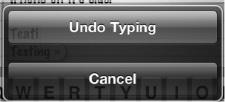

TIP: Delete Text Quickly
If you ever want to delete a number of lines of text, a paragraph, or even all the text you just typed quickly with only one or two taps, this tip is for you. First, use the techniques described previously to select the text you want to delete. Next, simply press the Delete key ![]() in the lower-left corner of the keyboard to delete all the selected text.
in the lower-left corner of the keyboard to delete all the selected text.
Finding Things with Spotlight Search
The Spotlight Search is a great feature on your iPhone that helps you find information. This is a proprietary search method from Apple for performing a global search on your iPhone. You can use this feature to search for a name, event, or subject.
The concept is simple. Let’s say you are looking for something related to Martin. You cannot remember if it was an e-mail, a document in Notes, or a Calendar event; however, you do know it was related to Martin.
This is the perfect time to use the Spotlight Search feature to find everything related to Martin on your iPhone.
Activating Spotlight Search
First, you need to bring up the Spotlight Search page, which resides to the left of the first page of the Home screen.
![]()
On the left side of the first circle (indicating the first page of your Home screen), you can see a very small Magnifying Glass icon.
Swipe your finger from left to right on the first page of icons to see the Spotlight Search page. You can also press the Home button from your first screen of Icons to see this same search page.
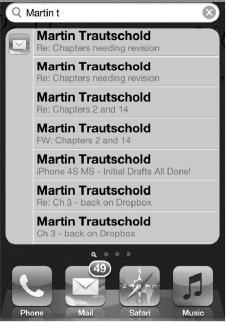
Follow these steps to perform a search with this feature:
- On the Spotlight Search page, type in one or more words as your search parameters.
- Tap the Search button in the lower-right corner to execute your search.
TIP: If you are looking for a person, type his full name to more accurately find items from only that person (for example, “Martin Trautschold”). This will eliminate any other Martins who might be in your iPhone, enabling you to find items only related to Martin Trautschold.
- In the search result, you’ll see all e-mails, appointments, meeting invitations, and contact information the search finds. Swipe down to see more results.
- Tap one of the results in the list to view its contents.
Your search results stay there until you clear them. This means you can return to the Spotlight Search page to view your prior search results simply by swiping to the right from your Home screen.
To clear the Search field, just touch the X in the Search bar. To exit the Spotlight Search page, just press the Home key or swipe to the left.
Searching the Web or Wikipedia
After you perform a Spotlight Search, you will see two options beneath your results: Search Web and Search Wikipedia.
Tap either of these options to execute your search on the Web or in Wikipedia.
Customizing Spotlight Search
You can customize your Spotlight Search by removing certain apps or types of data from the search. You can even change the order in which each type of data is searched. This might be useful if you want to search only your Contacts and Mail messages—and nothing else. Or, if you know that you always want to search Mail first, then Calendar, and then Music—you could set those items in the proper order. Follow these steps to do so:
- Tap the Settings icon.
- Tap General.
- Tap Spotlight Search.
- To change the order of the items searched, touch and drag the right edge of the item with the three gray bars up or down.
- To remove a specific item from the search, tap it to remove the Checkmark icon next to it. Unchecked items are not searched by Spotlight Search.
- Tap the General button in the upper-left corner to return to the Settings app.
